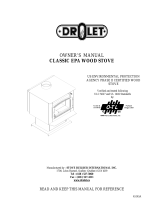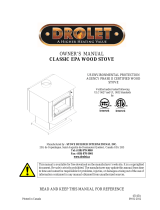
FLUES AND CHIMNEYS – SOME BASIC PRINCIPLES
1. The chimney top should be higher than any other part of the house or any nearby surrounding objects – see
installation code.
2. A straight chimney is best.
3. A chimney should be smooth on the inside.
4. The flue pipe and chimney should be inspected periodically and cleaned if necessary.
5. The smoke flue of a chimney must not be used for ventilation purposes. All openings apart from the one serving the
heating appliance must be sealed closed.
6. The chimney connection should be as short as possible with minimum number of elbows.
7. Any horizontal pipe should be pitched upward toward the chimney at least ¼” per foot of horizontal pipe.
8. Be sure that there is at least 18” (450mm) of clearance between horizontal single wall smoke pipe and the ceiling.
9. Do not connect any other appliance to the same flue.
10. Use three sheet metal screws to secure each joint.
11. For better performance, seal each vent pipe joint with a small quantity of furnace cement. Ensure the vent system
can be taken apart for periodic inspection.
12. All openings into a chimney must be closed off airtight, except the one in which your smoke pipe enters.
13. The chimney connector should not project into the flue and must fit tightly into the chimney hole.
14. The chimney connector must fit the collar on the stove tightly and should never be reduced in diameter from that
point.
15. The chimney connector must not be made smaller where it enters the chimney hole. Enlarge the hole if necessary.
16. The hardest work for a chimney is when the fire is first started, as the air in the flue is damp and the temperature
lower than it will be when the fire is well under way.
17. The draft in the chimney is more dependent upon the amount of hot air thrown into it than upon its size.
18. A chimney may be much too large for ordinary house requirements, but there is little danger of its being too high
where draft in concerned.
19. The effective area of a chimney is the area at the smallest part. Therefore, see that it is not diminished by
obstructions.
20. Smoke and hot air will rise in a spiral column; therefore, a round flue is best, as cold air cannot fall in the corners.
21. Long narrow flues are apt to cause trouble.
22. Chimneys built on the outside of a house must be at least 8" thick to prevent chilling the flue space within.
23. The chimney must be installed in accordance with these instructions and the chimney manufacturer’s instructions.
OUTSIDE COMBUSTION AIR
Provision for outside combustion air may be necessary to ensure that the heater does not discharge products of
combustion into the house. If in doubt, it is advisable to provide additional air.
For outside combustion air make-up, Newmac recommends that an opening, of 12 sq. inches (78 sq. cm.) free area be
provided to the room in which the heater is installed. If the air is ducted from outside, a 4 inch round duct (to a maximum
of 50 equivalent feet or 15m) should provide sufficient combustion air. If a duct is used, it should terminate at least 1
foot (0.3m) from the appliance and not be directly connected to it.
Outside combustion air may be required if:
a) the heater does not draw steadily, experiences smoke roll-out, burns poorly, or back-drafts whether or not there is
combustion present;
b) existing fuel-fired equipment in the house, such as fireplaces or other heating appliances, smell, do not operate
properly, suffer smoke rollout when opened, or back-draft whether or not there is combustion present;
c) any of the above symptoms are alleviated by opening a window slightly on a calm (windless) day;
d) the house is equipped with a well-sealed vapor barrier and tight fitting windows and/or has any powered devices
which exhaust house air;
e) there is excessive condensation on windows in the winter; or
f) a ventilation system is installed in the house.
If these or other indications suggest that infiltration air is inadequate, additional combustion air should be provided from
the outdoors
Make sure that any code requirements are satisfied when installing combustion air make-up.























